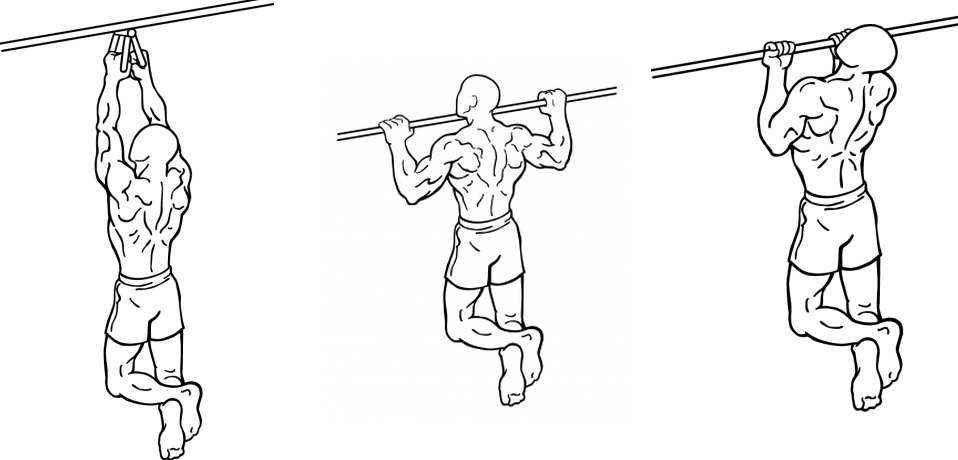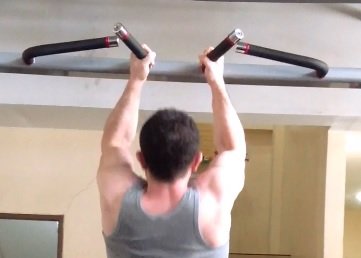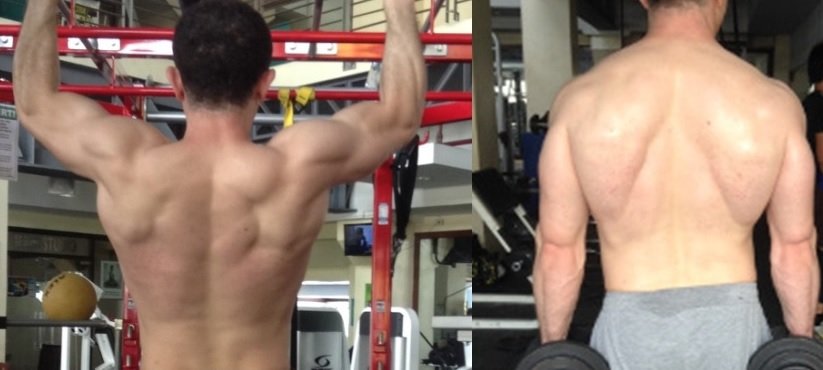
Doing Pull-Ups (or Chin-Ups) works your lats so it’s a great way to build a bigger and wider back.
There are various ways to grip the bar when performing a pull-up or a chin-up.
- A pronated (overhand) grip where your palms point outwards so that they are facing away from you.
- A supinated (underhand) grip where your palms point inwards so that they are facing you. (Also known as chin-ups)
- Neutral Grip – A “semi-supinated” grip where your palms are facing each other.
There’s also the grip width:
- Wide grip where you grip the bar wider than shoulder-width.
- Close grip where you grip the bar equal to or closer than shoulder width.

With all the combinations, you can do a pull-up (or a chin-up) in 6 different ways. That’s a lot of options.
Pull-ups are extremely challenging so you don’t want to waste your precious efforts with an inferior combination.
Which combination gives you the most bang for your buck? Let’s first look at the grip width.
A Close Grip Or A Wide Grip?
Wide grip pull-ups are falsely believed to help build a wider back. It’s plain logic. It’s believed that the wider you grip the bar, the wider parts of your back muscles will be activated.
The reality doesn’t work like that. I will quote six times Mr. Olympia champion Dorian Yates about wide grip vs close-grip pulls.
In my early career, I experimented with various types of grips, and I found that using a closer grip with the hands either parallel (facing each other) or fully supinated (underhand) actually provided the best contraction and most complete range of motion for the lats. Throughout my Mr. Olympia reign, I never did a single set of wide-grip chins or lat pulldowns.
A final reason to consider using a close grip beyond the issue of range of motion is the fact that it puts the biceps in a stronger position. Since the biceps are far smaller and weaker than the lats, putting them in a position where they are guaranteed to fail before the lats are properly stimulated, as in any wide-grip vertical pull, will cause you to shortchange your potential growth.
Dorian Yates also tweeted this:
So, we learned that wide grip pulls don’t work your lats in full motion so they are not effective to build wider lats. Moreover, wide grip pulls put more stress on your biceps. Biceps are smaller muscles so they’ll give up before your lats. When your biceps give up you’ll end the exercise without fully training your lats.
Winner: Close grip.
Neutral, Supinated (Chin-Up) or Pronated Grip?
Yates prefers to grip the bar neutrally (hands facing each other) or fully supinated (underhand).
Note that Dorian Yates is talking about pulldowns. It’s easier to do pulldowns with a fully supinated (underhand) grip when you hold the bar with a narrow grip.
But what about pull-ups?
In my experience, doing close grip pull-ups with a fully supinated (underhand) grip is taxing on my wrists. My wrists give up before I properly train my lats.
Doing close-grip pull-ups with a neutral grip (with hands parallel, facing each other) is a lot more comfortable.
Here’s how I grip the bar when doing pull-ups:

Doing lots of pull-ups is an essential component of my strength training routine. I only do close, neutral grip pull-ups and my back is lacking in neither strength nor width:

Winner: Neutral grip.
Final Verdict
For a wider and stronger back, do close, neutral grip pull-ups.
What If Your Pull-Up Bar Is Not Suited For A Neutral Grip?
When I first started strength training, I wasn’t able to do a single pull-up so I bought a simple pull-up bar for home use which looked like this:

I didn’t know at the time that neutral grip is the best type of grip for pull-ups. After doing many negative pull-ups, I finally managed to do a proper pull-up but I was still gripping the bar the wrong way. I was having a hard time increasing the number of pull-ups I did.
After I discovered that I can do more pull-ups with a neutral grip, I bought a pull-up bar which had handles to enable a neutral grip. My number of pull-ups were rapidly increasing but I had an unfortunate accident when I once got careless, the pull-up bar got dislocated from the door, and I fell to the concrete floor on my back. I almost broke my back (but I didn’t) and I took a long break from training until my bruises healed.
In the meantime, I moved to another house and there were plenty of outdoor establishments around to do neutral grip pull-ups so I no longer needed to buy another pull-up bar. If I were to buy a pull-up bar again, I would buy a model that can be screwed onto the wall so that it doesn’t easily get dislocated when doing pull-ups. Something like this:

Nowadays I do my neutral grip pull-ups in outdoor establishments:

If you have no way of doing neutral grip pull-ups then at least never do wide-grip pull-ups. Wide grip pull-ups fail to effectively train your lats so they are essentially a waste of time.
How To Perform Your First Proper Pull-Up And Increase The Number Of Pull-Ups You Can Do
Pull-up is a challenging exercise. There’s no shame in not being able to do a proper pull-up. I wasn’t able to do a single pull-up when I started but now I can do 30 pull-ups in a row.
Here are the steps to perform your first proper pull-up and then, increase the number of the pull-ups you can do:
1. Start With Negative Pull-Ups
The difficult part of the pull-up is the part where you pull yourself up. If you can’t pull yourself up (yet), don’t be frustrated. Skip the pulling yourself up part of the pull-up and concentrate on the part where you are lowering yourself down (the negative portion).
Here’s how to perform a negative pull-up:
- Grab the bar with your feet on the floor and grip it (preferably neutral with a narrow grip, if not, overhand with shoulder-width grip).
- Jump up to get your chin above the bar.
- Lower yourself slowly and in control until you get back down to your initial gripping position.
- Repeat from step 2.
Doing negative pull-ups is a great way to strengthen your back muscles. When you build up enough strength by doing negative pull-ups for a while, you will be able to do a proper pull-up.
2. Lose Fat
Another thing you can do to improve your pull-ups is to lose fat. If you have extra pounds of fat in your body, it will be harder for you to perform a proper pull-up as you will have to lift more weight when pulling yourself up.
When you slim down, you increase your chances of doing a proper pull-up, and later increase the number of pull-ups you can do.
3. Supplement With Other Compound Strength Training Exercises
If you are doing bodyweight training (which I highly recommend for beginners) then doing compound exercises such as burpees, push-ups, bodyweight squats, etc. will improve your overall musculature and will help increase the number of pull-ups you can do.
If you are lifting weights then deadlifts, rows, farmer walks, squats, and press exercises will train your back muscles along with the other muscles in your body and help increase the number of pull-ups you can do.
Be sure to read:
- Ripped with Bodyweight: 12-Week Program for Muscle Growth and Fat Loss, Chapter 4: Exercises
- Ripped with Bodyweight: 12-Week Program for Muscle Growth and Fat Loss, Chapter 8: The Workouts & The Routines
- 8 Best Bodyweight Exercises to Build Muscle, Burn Fat and Get Ripped at Home Without Weights
- Building Strength and Muscle: Bodyweight Training (Calisthenics) vs Weightlifting
- Training and Diet Principles to Get an Athletic Body